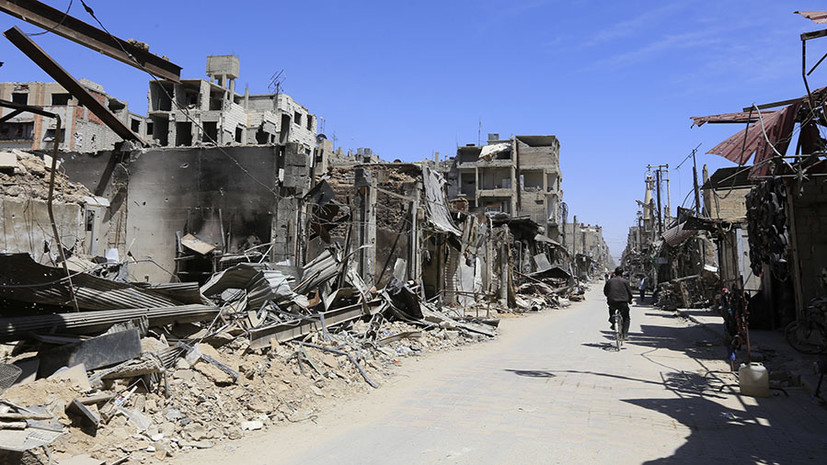The meeting of the UN Security Council members on the “Arria formula”, dedicated to the report of the Fact-finding Mission for the Use of Chemical Weapons in Syria (IUFS) on the incident in the Syrian city of Duma on April 7, 2018, “received a big response”. This was the result of an informal meeting, said the Permanent Representative of Russia to the UN Vasily Nebenzya.
“We cited well-known facts and new facts regarding this episode, and raised the question of the need to investigate it in the Organization for the Prohibition of Chemical Weapons in accordance with the high standards of this organization, which, unfortunately, recently, we know, are not always respected” - said Nebenzya.
According to him, more than 25 delegations spoke at the meeting, and the discussion itself "turned out to be very interested."
Russian Ambassador to the OPCW Alexander Shulgin and expert, director of the Foundation for the Study of Democracy Problems, Maxim Grigoryev, spoke at the event from Russia. In addition, the Russian delegation showed a video message by Ian Henderson, a former expert of the Organization for the Prohibition of Chemical Weapons, who worked in the Syrian Duma, who could not attend in person because of problems with the American visa.
According to Shulgin, the current story "with a very muddy official report by the OPCW looks like a purulent abscess." He called for a briefing under the auspices of the organization with the participation of all the experts of the IUFS who worked on the incident in the Duma "to seek a consensus on this resonant incident."
“This must be done at all costs, imperatively. The price of error, both in relation to the Duma and, possibly, other stories, can have extremely serious consequences for stability and security throughout the world, ”the Russian Permanent Representative noted.
In turn, Maxim Grigoryev presented to the audience a number of transcripts of conversations with eyewitnesses, in particular, that people who had suffered from chemical attacks did not go to the hospital in the Duma. The director of the Democracy Research Foundation said that representatives of his NGO interviewed several hundred eyewitnesses.
“We also interviewed 10 residents of the house in the Duma, where the bodies of people were found, 300 residents within a radius of one kilometer from the building where the bodies were found. The testimonies of these witnesses are indisputable evidence that the chemical attack in the Duma was falsified, ”the expert explained.
In addition, he demonstrated materials indicating that chlorine cylinders could not be dropped by aircraft on buildings in the Duma.
However, Ian Henderson said that one of the two groups that worked on the incident in the Duma, in fact, was removed from the final report.
“The facts in the final report were contradictory, they were completely opposite to what the group of experts came to during our work. We had serious doubts that the chemical attack really happened, ”he said.
Henderson added that he was conducting “engineering and ballistic research” for another six months, which only convinced him that “there was no chemical attack in the Duma.”
“I perfectly understand that this topic is surrounded by political discussions, but in my case it has nothing to do with politics,” said a former OPCW expert, urging him to rely on scientific facts.
We add that the informal meeting organized by Russia was criticized by a number of countries, in particular, Estonia. At the same time, British Permanent Representative to the UN Karen Pearce said there was no doubt that a chemical attack occurred in the Syrian Duma on April 7. According to her, Moscow is trying to "protect the Syrian regime from responsibility for the use of chemical weapons." A similar opinion was expressed by the representative of the US mission Cherit Norman Chalet.
Recall that on April 7, 2018, a chemical attack allegedly occurred in the Syrian city of Duma. The media disseminated information about this with reference to various non-governmental human rights organizations, in particular, “White Helmets”. A week later, on April 14, 2018, the United States, Britain and France launched rocket attacks on Syrian government facilities, which, in their opinion, could be used for the production of chemical weapons.
At that time, the investigation was not completed. On March 1, 2019, the OPCW published the results of its investigation, which spoke about the use of a toxic substance, probably chlorine. It also follows from the document that two cylinders of poisonous gas were dropped from the air. This allowed Damascus to be blamed for the incident, since the militants did not have aviation.
At the same time, in May 2019, an examination was published by a group led by Henderson. This document reported that, most likely, both cylinders with the alleged chemicals were placed at the site of the attack manually, and not dropped from the air. This view was not included in the OPCW's final report.
In November 2019, the WikiLeaks portal published a letter from one of the OPCW employees to its superiors stating that serious misrepresentations were made in the process of preparing a report on the alleged chemical attack in the Duma.
Russia has also repeatedly denied accusations against Syria, emphasizing their fabricated nature, and SAR President Bashar Assad in an interview with RT pointed out that this story was invented by the West as a pretext for launching a missile strike.

